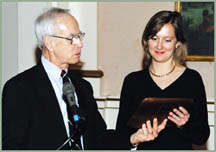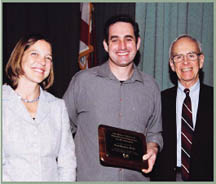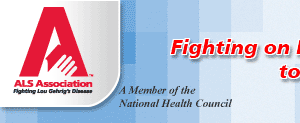ALS Research Update: A Conversation With ALSA’s Science Director
Lucie Bruijn, Ph. D. came to The ALS Association in 2001. As Science Director and Vice President of Research, Dr. Bruijn directs The ALS Association’s diverse research program, which is seeking to unravel the mysteries of ALS. Holding a bachelor’s degree in Pharmacy, a master’s degree in Neuroscience and a doctorate in Biochemistry, Dr. Bruijn developed and characterized one of the mouse models of ALS.
HOPE: What are the current major topics in ALS research?
BRUIJN: Certainly, one area we continue to focus on is understanding more about the disease and how it progresses. We know that it’s not only the motor neurons involved, the key cells affected in the disease, but also the surrounding support cells that can become toxic and no longer be protective or supportive. It’s a much more dynamic situation between different cell types and the motor neuron itself. This is one of the major findings in the last several years. Since there are probably multiple causes and processes involved in this complex disease, the whole concept of finding what initiates the disease is a difficult one. We recognize that genetics play a major role as well as how genes interact with the environment. Another area that has become of particular interest in this challenging disease is the field of biomarkers, which are signatures that differentiate between people who have the disease and those who don’t. This is important for two reasons; one is the possibility for earlier diagnosis. A major challenge for treatment has been that by the time a person’s ALS diagnosis has been confirmed, about 50 percent of the motor neurons have already died. Earlier diagnosis would allow treatment to begin earlier, and hopefully, prevent cells from dying. The other reason biomarker research is important is for what it could offer clinical trials. Biomarkers can track whether a drug is, in fact, making a difference. The search for new genes linked to ALS continues to be important. While the discovery of the copper zinc superoxide dismutase 1 (SOD1) mutation is significant, there are still 80 percent of the familial cases for which the genes have not been identified. Once more genes are identified, we hope to find that all these genes are linked in a common pathway. Perhaps there are common mechanisms involved in the disease, even though the initiation may be different. Of course, understanding sporadic ALS is important because it accounts for almost 90 percent of ALS cases, and there’s no known cause. As with familial ALS, we believe there is a gene and environment interaction. So, it is important to discover what genes are affected in the sporadic ALS as well as what environmental conditions or exposures trigger the disease. In addition, the focus on therapy and drug development, the ALS registry (see article on page five) and the NINDS (The National Institutes of Neurological Disorders and Stroke) ALS Repository (see article on page one) are areas that will provide very important data and resources.
HOPE: Please describe the concept of TREAT ALS and the impact we hope it will have on ALS research.
BRUIJN: TREAT ALS stands for Translational REsearch Advancing Therapies for ALS . The concept is to take promising ideas from the lab and push them into the clinic. TREAT ALS enhances and consolidates the efforts of ALSA’s overall research program. Most of the initial research has been on understanding the disease. This understanding led to the establishment of model systems to test concepts. Through partnerships with the biotech and academic sectors, we plan to use FDA-approved compounds that have not been used in ALS cases to identify those that may be of value in continued testing. The idea is to move rapidly and develop pilot studies to determine dosage, administration routines and design clinical trials that will enable larger clinical studies. In parallel and under the TREAT ALS umbrella, there is a strong need to develop new compounds. So far, most of the drugs tested for ALS have come from other areas, either other neurological diseases or, in the case of Minocycline, a compound that has normally been used for its antibiotic properties; however, its value for ALS is thought to be for other properties. Unfortunately, many of the drugs that are being tested have limitations because they weren’t specifically designed for ALS. For instance, the original use may not require blood-brain barrier penetration; therefore, the delivery of the drug is a challenge. Through this program, we will develop contracts with biotech companies and academia to screen more library compounds in the model systems of ALS. Our ultimate goal will be to develop compounds that are suited to the treatment of ALS. However, through our collaborations with biotech companies, industry, academia, and excellent advisors from the NIH (National Institutes of Health and the FDA (Food and Drug Administration) and consultants to help us, we hope to develop effective compounds for the clinic.
 |
ALSA National Trustee and Research Committee Chair Robert Abendroth presents award to Agnes Lukazewicz, one of two recipients of The Milton Safenowitz Post-Doctoral Fellowship for ALS Research. |
HOPE: How is ALSA attempting to bring talented researchers into the field of ALS research?
BRUIJN: It is critically important to increase the pool of new, talented investigators in the field of ALS research. ALSA has always focused on this and has several programs to attract independent investigators with new ideas. Every second year at a workshop, we bring together new investigators who are beginning to establish independent scientific careers, with the goal of stimulating discussions and collaborations among their peers. We often invite investigators who are more established in the field of ALS to provide mentorship and direction. Engaging these investigators in a nurturing, enthusiastic environment, we demonstrate that support and tools are available. We enhanced this concept further by initiating The Milton Safenowitz Post-Doctoral Fellowship program with a key goal of getting investigators excited about ALS research at the beginning of their careers. We nurture them throughout the postdoctoral fellowship, providing resources and directing them to experienced professionals for support, so it’s more than just receiving an award. We involve them in the ALS community right from the beginning. In just a few short years, the post-doctoral fellowship has introduced some very talented candidates who are very engaged and eager to move through a career in ALS research.
HOPE: Please describe the relationship between research and funding, and what role the donor plays.
BRUIJN: Our donors are absolutely critical to ALSA’s research effort. Without our supporters, we would not be able to embark on ambitious programs such as TREAT ALS or collaborate with leading scientists and institutions around the world in the quest to find the answers to ALS. It’s through donor support that we have been able to fund the research that has brought about such breakthroughs as finding the SOD1 ALS gene and the development of mouse models that closely mimic ALS in humans, which provides researchers vital information about the disease. I see the real promise ahead in ALS research and the hope for therapies.
HOPE: How does ALSA’s research program fit into the international ALS community?
BRUIJN: In addition to domestic projects, ALSA has funded research projects outside the U.S. borders in places such as Europe, Australia, Canada and Asia. ALSA has brought many investigators to workshops. Through our ALSA-Initiated research program, we have encouraged collaboration in the search to identify new genes associated with ALS. We recognized that the faster new genes are identified, the more promising therapies can be. ALSA also participates in consortia with the U.K., Belgium and the U.S. to share patient information, and there are plans to broaden the consortia. We are very open to collaboration with the international community, especially where large projects require patient material, patient resources and clinical information. In addition, ALSA is represented at national and international conferences and meetings.
 |
Lucie Bruijn and Robert Abendroth with
Eran Perlson, Ph.D., a recipient of
The Milton Safenowitz Post Doctoral Fellowship for ALS Research |
HOPE: What are the biggest obstacles to ALSA’s effort to find effective treatments and a cure for ALS?
BRUIJN: Because ALS strikes relatively few people, as compared to a disease such as Alzheimer’s disease, ALS is considered an orphan disease. Consequently, large pharmaceutical companies have not focused on ALS. ALSA supports drug development at the early stages to reduce the initial risk for pharmaceutical companies. In addition, ALSA supports the development of compounds that could also hold promise for other diseases, and thereby increase the market potential. A program like TREAT ALS can fill the gap and encourage the pharmaceutical industry to develop the drugs to cure or slow the disease. ALSA also works with biotech companies, who are more willing to take risks. Another challenge is that ALS is such a complex disease involving many genes, unlike Huntington’s disease that has only one genetic cause. At present, only the mutant SOD-1 gene has been absolutely identified as a cause of ALS, but it only accounts for approximately two percent of the cases. The next challenge is that ALS affects people so differently. Disease onset, progression rate and the way the disease manifests itself vary widely; therefore, clinical trials must be designed creatively and comparatively lengthy to measure the treatment over time. Unlike treating an infection, where you give a compound and see if the infection clears away, the measure to see if there is an improvement in ALS is much more challenging.
HOPE: What makes ALSA’s approach to research so significant?
BRUIJN: ALSA funds a broad spectrum of research because no one knows where the promise lies, and we have to be open to all possibilities. The answers may come from unexpected areas of research. We consider a variety of projects that perhaps would not be funded initially by the government: the National Institutes of Health (NIH). We give an investigator seed money to crystallize an idea that often leads to a substantial NIH grant. In addition to funding a broad spectrum of projects, ALSA uses several funding vehicles. Some programs are quite structured, such as our Investigator Initiated grant program, with two cycles, annually. Abstracts are submitted and reviewed by a panel on a regular schedule. However, we have built in flexibility to accommodate a novel idea that might come between cycles and thus avoid waiting up to six months before providing funding. At times, while working directly with investigators, we have developed novel projects together and rapidly moved through review and initiated research. ALSA believes in collaboration, and, therefore, partners with academia, industry, and other non-profits. However, we feel strongly that each project should be peer reviewed. Finally, with TREAT ALS in our portfolio, we consider research at the basic lab levels, how best to move it forward, partner with government agencies, do pre-clinical work when necessary, and move to the clinical trial stage. Every part of our program has a reason for being and is very complementary.
HOPE: ALSA partners with several government agencies in ALS research. How do these partnerships further the cause of finding treatments and a cure?
BRUIJN: Over time, government partnerships have elevated ALSA’s credibility as an organization that selects appropriate research to fund. We work closely with NINDS (The National Institute of Neurological Disease and Stroke) on various projects. For example, ALSA provided supplemental funding in an FDA approved drug screen. Currently, many representatives from NIH and FDA are advisors on the new TREAT ALS program, together with academic and industry partners. In addition, through our Investigator Initiated research program, we fund novel projects that may not be eligible for funding through the NIH. Frequently, these projects generate valuable data. ALSA collaborated with organizations and researchers to develop the NINDS ALS repository, where blood samples are collected from ALS patients. ALSA’s continued collaboration with NINDS has resulted in several important clinical trials. NINDS is currently funding five of these trials. In addition, ALSA is working closely with the Department of Veterans Affairs to build a registry of veterans with ALS. We also feel that a complementary national registry of all people with the disease would be of tremendous benefit.
HOPE: What are some of the promising areas of ALS research in the next few years?
BRUIJN: Biomarkers hold a lot of promise, as early diagnosis affords the opportunity for earlier intervention. Genetics continues to be a promising area, especially as technology has become better and the costs have gone down. Another area that is extremely exciting is the use of novel therapeutic technologies such as antisense and RNA-i technology. Antisense is the delivery of a therapeutic agent that will block the production of an abnormal protein. For example, the SOD1 mutant gene, which is linked to approximately 20 percent of familial cases, produces a toxic protein that negatively affects the motor neurons and surrounding cells. It is not understood exactly what the toxicity is; however, experimental studies have demonstrated that if this toxic product is removed, the condition of the disease is improved. This technology was developed in a partnership of an academic lab and a biotech company, Isis. The investigators, The ALS Association and Isis are moving forward to develop full clinical trails. The idea is to deliver a therapeutic agent, which will block the production of mutant SOD1, and we hope, if early enough in the disease progression, it will significantly slow or halt the disease and make a major impact for people who have the SOD1 mutation. We recognize that the benefit is for only approximately 2 percent of ALS patients, but as we learn more about other causes and other genes, we can develop similar therapies using antisense. This novel approach is moving rapidly from an idea in the lab to consideration for clinical trial. Along the same line is the concept and the use of RNA-i technology, which is a similar technology with a different therapeutic agent being administered. These technologies, along with the focus on collaboration, such as partnerships with government agencies, industry, and the international community, hold great promise for ALS research in the next few years.
|



